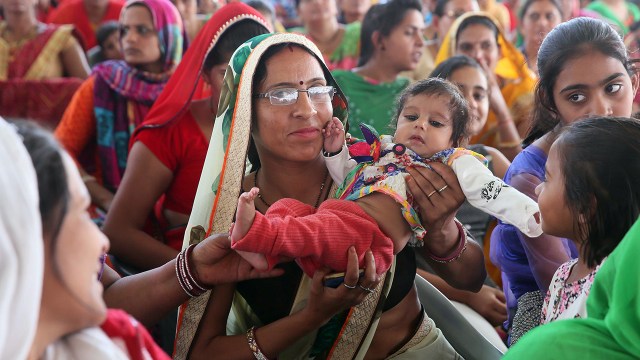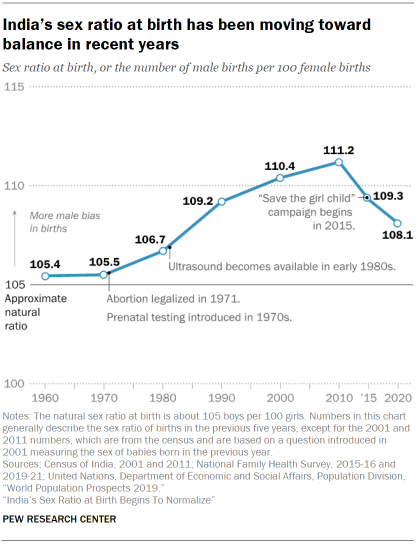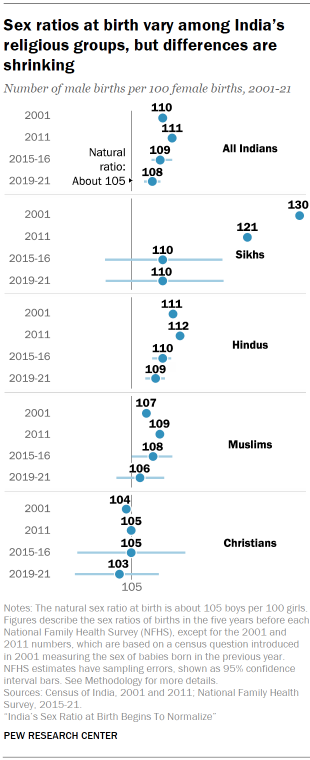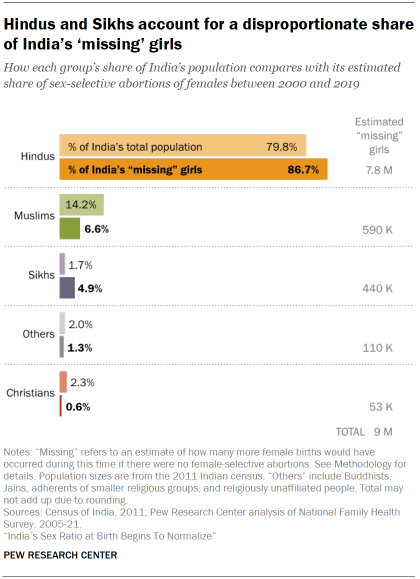Son bias declines sharply among Sikhs, while Christians continue to have a natural balance of sons and daughters

This study describes India’s sex imbalance at birth and how it has been changing, both nationally and within major religious groups. The report focuses on India’s four biggest religious communities – Hindus, Muslims, Christians and Sikhs – because there is not enough fertility and health data to make reliable estimates for smaller groups, such as Buddhists, Jains, adherents of other minority religions, and religiously unaffiliated people. However, members of these and many other smaller religious groups are included in general population results at the country, regional and state levels.
Sources: Most of the analysis is based on the Indian government-supported National Family Health Survey (NFHS) and the official census of India. The most recent data is from the fifth wave of the NFHS, conducted from 2019 to 2021. The most recent census data is from 2011, because India’s 2021 census was delayed by the coronavirus pandemic.
Terminology: “Son preference” is a phrase standardly used by scholars to describe the outlook of parents who engage in gender-biased sex selection, using abortions to give birth to more males and fewer females than would occur naturally. However, researchers sometimes also refer to “daughter aversion” as the underlying cause of skewed sex ratios at birth in India. Both phrases are used in this report, because “son preference” and “daughter aversion” are closely linked and often interchangeable. For more details, see “Is it son preference or daughter aversion?”
Ratios: It is natural for women to give birth to more boys than girls, on average. International convention is to present sex ratios at birth as the number of boys per 100 girls. The natural sex ratio at birth is about 105 boys per 100 girls. In India, however, this ratio is often expressed as the number of girls per 1,000 boys, in which case the natural ratio at birth is about 950 girls per 1,000 boys. This report follows the international practice, presenting ratios as the number of boys per 100 girls. Here is a sample of how the same values are expressed in each system:

See the Appendix for a table converting all sex ratio statistics used in this report.
Numbers: India’s number system differs from the international one. Indians use units such as lakhs and crores, placing commas at different intervals. This report presents numbers in the international system and, in parentheses, the Indian system. For example:

India’s artificially wide ratio of baby boys to baby girls – which arose in the 1970s from the use of prenatal diagnostic technology to facilitate sex-selective abortions – now appears to be narrowing, according to newly released data from the country’s National Family Health Survey (NFHS).

The new data suggests that Indian families are becoming less likely to use abortions to ensure the birth of sons rather than daughters. This follows years of government efforts to curb sex selection – including a ban on prenatal sex tests and a massive advertising campaign urging parents to “save the girl child” – and coincides with broader social changes such as rising education and wealth.
Among India’s major religions, the biggest reduction in sex selection seems to be among the groups that previously had the greatest gender imbalances, particularly Sikhs.1
Naturally, boys modestly outnumber girls at birth, at a ratio of approximately 105 male babies for every 100 female babies. That was the ratio in India in the 1950s and 1960s, before prenatal sex tests became available across the country.2
In the 1970s, prenatal gender tests, conducted using amniocentesis, were rare and expensive. Since the introduction of ultrasound technology in the 1980s, gender testing has become more widespread and affordable.
Abortion was legalized in the country in 1971. Once prenatal testing allowed Indian families to learn the sex of a fetus during pregnancy, sex selection took off. The sex ratio at birth widened rapidly from about 105 boys per 100 girls before 1970, to 108 boys per 100 girls in the early 1980s; it reached 110 in the 1990s and remained at that level for roughly 20 years.
The NFHS is a large-scale survey of Indian households that has been conducted five times since 1992-93. It is sponsored by the Indian government with additional funding from a variety of sources, including the U.S. Agency for International Development, the Bill and Melinda Gates Foundation, and UNICEF.
The NFHS is designed to provide India’s Ministry of Health and Family Welfare with reliable data on fertility, maternal and child health, family planning and related topics. But because it interviews a random sample of the population, estimates from the NFHS are less precise than those from the census, the amount of sampling error being larger for estimates among smaller religious groups. For example, the NFHS’s estimate of the national sex ratio at birth (108 boys per 100 girls) has a margin of sampling error of plus-or-minus 1 boy per 100 girls. Among Sikhs, the smallest religious group in this study, the estimate (110 boys per 100 girls) has a wider margin of error of plus or minus 8 boys per 100 girls.
There will be more certainty about India’s current sex ratio at birth after results from the 2021 Indian census – which was delayed by the coronavirus pandemic – are released. (For more about estimating sex ratios at birth and confidence intervals, see the Methodology.)
From a large imbalance of about 111 boys per 100 girls in India’s 2011 census, the sex ratio at birth appears to have normalized slightly over the last decade, narrowing to about 109 in the 2015-16 wave of the National Family Health Survey and to 108 boys in the latest wave of the NFHS, conducted from 2019-21.
Nonetheless, a Pew Research Center analysis of United Nations estimates reveals that during the two decades between 2000 and 2020, India on average had one of the world’s most skewed sex ratios at birth, after Azerbaijan, China, Armenia, Vietnam and Albania.3
Around the world, sex selection is often attributed to “son preference” (or “daughter aversion”), a form of gender bias in which families prioritize having sons over daughters for economic, historical or religious reasons. In India, son preference may be tied to cultural practices that make daughters more costly to raise than sons. In Indian tradition, only sons pass down the family name, thereby carrying on the family lineage, and Hindu sons are expected to perform last rites for deceased parents, including lighting the funeral pyre and scattering their ashes. Sons have also been a way for families to preserve ancestral property because males generally dominate inheritance lines (even though most Indian inheritance laws now prohibit gender discrimination).
Daughters, meanwhile, often take wealth away in the form of large dowries at the time of marriage, with payments sometimes continuing throughout a daughter’s life. And while sons continue to live in the parental home after marriage, with wives who often become the primary caregivers for aging in-laws, a daughter is expected to move away from her parents and into her husband’s family home. (See the “Laws, norms and traditions” sidebar for more details.)
Scholars have noted that these cultural and religious traditions are often tied to geographic norms; in Northern and Western India, for example, patriarchal and patrilineal family systems are more dominant than in other parts of India, particularly the South.4 (See Wealth, education and regional distribution tied to differences among religious groups for more details.)
Even though it has been illegal in India since 1996 for doctors and other medical practitioners to reveal the sex of a fetus to the prospective parents, at least 9.0 million (0.9 crore) female births went “missing” between 2000 and 2019 because of female-selective abortions, according to a Pew Research Center analysis of data from multiple waves of the NFHS and India’s census.
To put the recent decline in sex selection into perspective, the average annual number of baby girls “missing” in India fell from about 480,000 (4.8 lakh) in 2010 to 410,000 (4.1 lakh) in 2019, the Center’s analysis finds.
“Missing” is a term demographers and economists use to describe the deficit in a population caused by discriminatory family planning practices, largely female-selective abortions and female infanticide. Nobel Prize-winning economist Amartya Sen in 1990 was the first to draw international attention to the concept of “missing” women in a groundbreaking article in The New York Review of Books.
To approximate the number of “missing” girls due to sex-selective abortions (excluding post-birth infanticide or femicide), scholars generally compare the actual number of newborn girls with the number that would be expected if there were no sex selection. Without sex selection in India, the sex ratio at birth would be roughly 105 boys per 100 girls.5 This natural sex ratio at birth was the balance for decades before prenatal sex detection technology was introduced in the 1970s.
When the natural sex ratio at birth prevails, about 48.8% of all children born are girls. In India, on average, about 47.9% of children born between 2000 and 2019 were girls. The gap between these statistics represents “missing” girls – those who were not born, due to sex-selective abortions.
Using three waves of data from the National Family Health Survey (NFHS), Pew Research Center estimates there were 9.0 million (0.9 crore) “missing” girls between 2000 and 2019 in India.
The Center’s estimate of “missing” girls due to sex-selective abortions is smaller than estimates published by some other scholars.6 This discrepancy is partly because other studies often cover earlier time periods, and partly because the survey data Pew Research Center researchers relied on – the NFHS – seems to produce relatively conservative, less male-biased sex ratios at birth in India than some other sources. (See this report’s Methodology for discussion of differing estimates of the number of “missing” girls.)
Sex ratios at birth and ‘marriage squeezes’ differ among religious groups

In the past, some of India’s major religious groups varied widely in their sex ratios at birth, but today there are indications that these differences are shrinking. Sikhs, who in past decades had a particularly large imbalance of baby boys to girls, now seem gradually to be moving toward the natural level, as well as converging with other groups.
In the 2001 census, Sikhs had a sex ratio at birth of 130 males per 100 females, far exceeding that year’s national average of 110. By the 2011 census, the Sikh ratio had narrowed to 121 boys per 100 girls. It now hovers around 110, about the same as the ratio of males to females at birth among the country’s Hindu majority (109), according to the latest NFHS.
In recent decades, Christians also have stood out from India’s other religious groups, but in the opposite direction: India’s Christian minority has maintained a sex ratio at birth around the natural level of 105 boys per 100 girls, indicating a relatively low incidence of sex-selective abortion in the Christian community. Indian Muslims also now have a sex ratio at birth (106 boys per 100 girls) that is close to the natural norm seen in India prior to the introduction of prenatal testing.
Aborting females may have consequences that reverberate beyond the families making the choice. International research shows that societies with high rates of sex-selective abortions typically suffer within a couple of decades from a shortage of marriageable women and a surplus of men seeking brides. This “marriage squeeze” can trigger a variety of social problems, such as increases in sex-related violence and crimes and trafficking of women.7 Even if India’s sex ratio at birth continues to normalize, the large number of girls “missing” from its population could continue to have profound consequences on Indian society for decades to come.

Religious groups are already experiencing varying magnitudes of marriage squeeze, depending on their history of sex selection, as few Indians marry outside their religion. Sikhs, in particular, face an acute shortage of single women of marriageable age. Sikhs make up less than 2% of the Indian population but accounted for an estimated 5%, or approximately 440,000 (4.4 lakh), of the 9.0 million (0.9 crore) baby girls who went “missing” in India between 2000 and 2019.
The share of “missing” girls among Hindus is also above their respective population share. Hindus make up 80% of India’s population but accounted for an estimated 87%, or approximately 7.8 million (0.8 crore), of the females “missing” due to sex-selective abortions.
The share of female births “missing” among Muslims and Christians during this period is lower than each group’s share of the Indian population, meaning they were less likely than others to engage in sex-selective abortions. Muslims, who make up about 14% of India’s population, accounted for 7%, or approximately 590,000 (5.9 lakh), of the country’s “missing” girls. Christians, who make up 2.3% of the population, have had an estimated 0.6%, or about 53,000 (0.5 lakh), of the total number of sex-selective abortions.
Aside from religion, many demographic factors are tied to sex selection
Abortion laws and practices in India
Abortion is legal in India up to the 24th week of pregnancy under a range of criteria, including to save a woman’s life. Abortions are allowed after the 24th week if a medical board of at least three experts detects “substantial fetal abnormalities.”
However, the use of ultrasound devices and other technologies to determine the sex of fetuses is prohibited, and violators – including family members who seek this information and medical personnel who provide it – face fines and even imprisonment.
It is difficult to know exactly how many abortions take place in India each year, because the stigma surrounding abortions leads to serious underreporting. For example, while the most recent National Family Health Survey finds that around 3% of pregnancies in India end with an abortion in any given year, academic researchers often estimate the number to be much higher. A 2018 study published in The Lancet suggests that roughly half of pregnancies in India are unintended, and that there were 15.6 million (about 1.6 crore) induced abortions in 2015 alone – roughly one-third of all pregnancies that year. The 2018 study finds that most abortions in India take place using medications outside of health facilities. (Such medications are commonly purchased at pharmacies or from informal vendors.)
It is likely that sex-selective procedures account for only a small fraction of all abortions in India, given that about 9.0 million (0.9 crore) sex-selective abortions were performed between 2000 and 2019, according to Pew Research Center’s estimate.
A review of the academic literature indicates that this is the first published report to estimate the numbers of females “missing” at birth in India by religious group. However, the estimates are not meant to suggest that differences in childbearing choices are caused solely by religion.
In India and around the world, family choices – such as how many children to have and whom to share a home with – are also bound up with a myriad of other factors, such as educational attainment, wealth, urbanicity and regional culture. Sex ratios at birth, too, appear to be linked to many demographic factors. Some characteristics of religious groups have competing influences on sex ratios.
For example, NFHS data shows that women who are wealthier and more educated are less likely to favor having sons.8 At first glance, this might lead some to expect that wealthier women and women with more education would be less likely to abort girls. Families who live in cities also are less likely than their rural counterparts to favor having sons, according to the NFHS, which may be because they are wealthier and more educated. (For a closer look at gender attitudes in India, see Pew Research Center’s survey report “How Indians View Gender Roles in Families and Society.”)
On the other hand, education, wealth and urbanicity can make it easier for a woman to get access to (and pay for) an ultrasound test or other prenatal sex screening. In India, undergoing such a test during pregnancy is correlated with a higher probability of giving birth to a son.9
Caste is a social stratification rooted in Hindu tradition but shared by other religious groups in India. Upper-caste status in particular has complex associations with sex selection. Brahmins and other upper-caste families, who are generally wealthier and more educated, may not need to worry about the cost of having a daughter.10 At the same time, upper-caste Indians, especially those in Northern and Western India, traditionally may have been more likely to observe rigid gender norms.11
Fertility and birth order also play an important role in these choices. Families who are planning to have just one or two children may be more inclined to abort a female to ensure having at least one son. In China, for example, the government’s former one-child policy, introduced in 1980, likely contributed to a widening of China’s sex ratio at birth.
Religion, meanwhile, is tied to these demographic characteristics in numerous ways. Adherents of a particular religion may live near each other and therefore have similar educational opportunities, economic challenges and fertility patterns. Religious groups also may share certain cultural norms or historical or geographical backgrounds, or a particular status in society, that influence their life choices and the expectations they pass on to future generations. In other words, many of the factors that affect sex selection are connected to each other – and to religious affiliation – in ways that are difficult to untangle.
This report does not attempt to determine the exact causal connections between religion and family choices. Its main goals are to describe the childbearing patterns and attitudes revealed in Indian census data and in surveys, and to use statistical techniques to show how these patterns vary by religion.
The rest of this report takes a closer look at each of the dynamics that underlie sex selection – namely son preference, ultrasound use and fertility – including a detailed analysis of trends in each of the major religious groups and across India’s six administrative regions. An overview of sex ratios around the world can be found in the next section. Subsequent sections include a summary of Indian religious groups’ demographic characteristics, and brief explanations of some of the Indian traditions, norms and laws referenced in this report.
This report was produced by Pew Research Center as part of the Pew-Templeton Global Religious Futures project, which analyzes religious change and its impact on societies around the world. Funding for the Global Religious Futures project comes from The Pew Charitable Trusts and the John Templeton Foundation.
Related India research
This is the fourth in a series of Pew Research Center reports on India. Other reports can be found here:
Religion in India: Tolerance and Segregation
CORRECTION: Due to an oversight, a previous version of the “Sex ratios around the world” sidebar stated an estimate of Armenia’s average sex ratio at birth between 2000 and 2020 that was derived from a different data source than estimates for other countries in the sidebar. To be consistent, the Armenia estimate has been updated based on data from the United Nations World Population Division. This change does not substantively affect the findings of the report.




